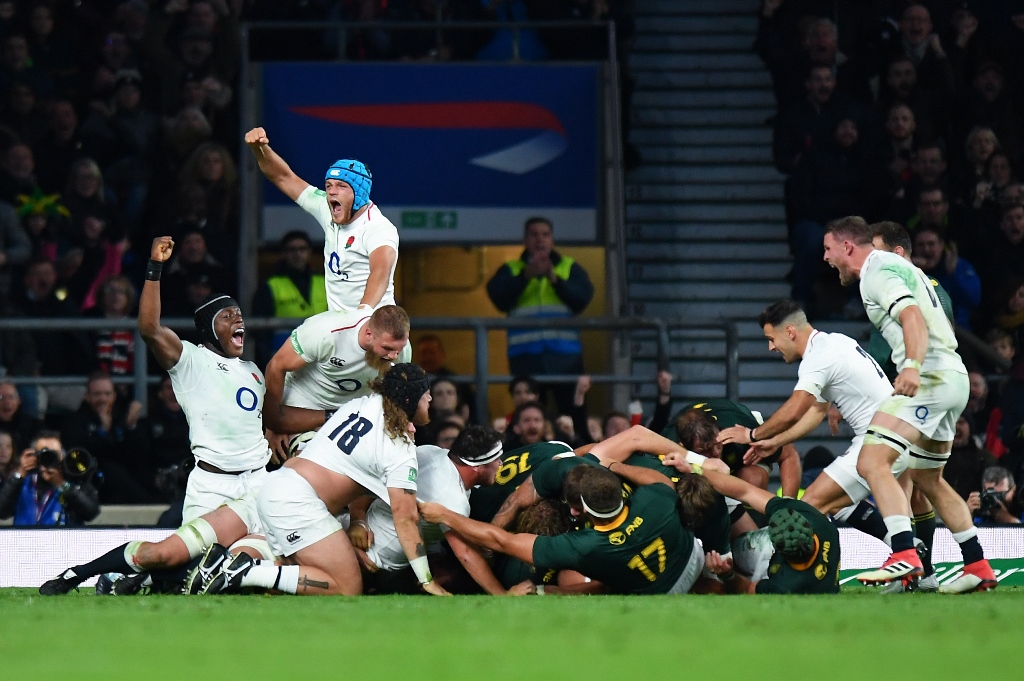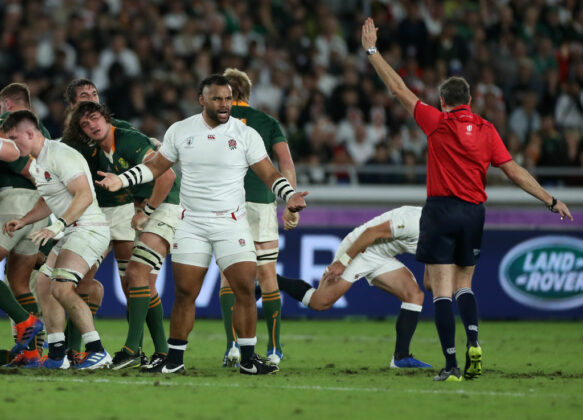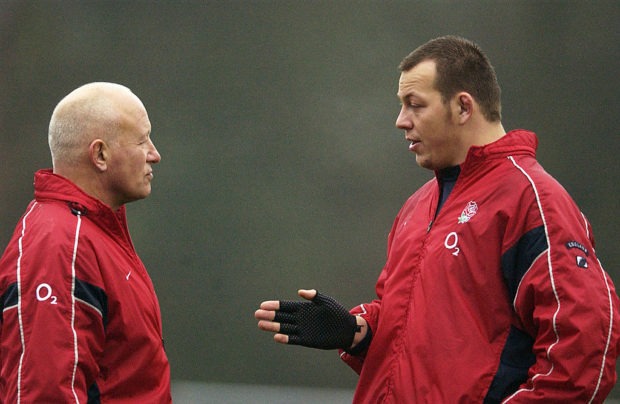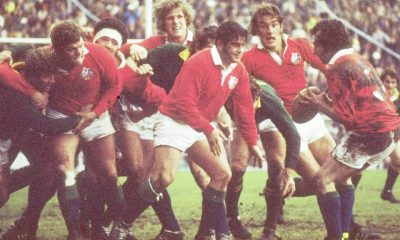
THE scrum has collapsed. That is not just a statement on the endless time-wasting and confusion among players and referees that brings half the scrums in the modern game to their knees – it is a statement about the survival of the scrum as a sacrosanct part of Rugby Union.
The scrum in its current form is being slammed from all sides – and it deserves to be. The main reason is that watching front row forwards and their pack colleagues take a knee, have a rest and a drink – as well as a chat with a water-carrier coach – is as boring as watching paint dry.
When, eventually, they are coaxed into forming a scrum by the referee, the purgatory for fans continues when it collapses in a heap and has to be reset.
This can happen three or four times more before the referee spots a front row technical infringement and awards either a penalty or a free-kick.
The upshot is that the scrum is incomplete, and often adds nothing to the contest, and yet players rush in from all corners of the pitch, to back-slap a prop or hooker lucky enough to win the penalty lottery.
By that time, four or five minutes of the match have been wasted. There have been suggestions that a way of handling these Mogadon minutes is to stop the clock, but that is not a viable solution unless you are interested in matches that last for 180 minutes, rather than 80, because it does not discourage the dawdling.
The Rugby Paper’s postbag, as well as comment forums on rugby social media, is overflowing with complaints from supporters who are deeply disillusioned with the degrading of the scrum, especially the recent law change that allows crooked or ‘favourable’ put-ins, when the scrum-half is able to sidestep towards his own hooker.
Broadcasters are equally frustrated with the way their live match coverage is being blighted by the tortuous engagement process, prolonged time-wasting, and constant collapsing and resets that characterise the modern scrum.
As a result there is a growing lobby for the scrum to be scrapped, and replaced by the-tap-and-go, taking yet another step towards 15-man Rugby League.
This would be a disaster because it would take away yet another layer of the variety of skills, physical attributes, and tactical deployments that make Rugby Union such an intriguing, multi-faceted team sport. The travesty is that when a scrum is coherent it adds an amazing amount to the contest, with South Africa‘s scrum dominance in the 2019 World Cup final a classic case of how it can be a hugely influential launchpad.
World Rugby in the dock
That is why attempts to undermine the scrum must be challenged, not least because the current debacle is not the fault of the scrum itself, but that of the lawmakers at World Rugby/IRB.
It is a consequence of one flawed scrum decision after another made by the world governing body’s laws committee over the past 15 years.
It has turned the scrum from a trial of strength and skill that made it a defining characteristic of Rugby Union – as well as an unrivalled platform for attacking play – into the game’s unwanted bastard.
There are two questions regarding the tarnishing of the scrum that supporters of the game want answering urgently: how has it happened, and how do we fix it?
The main culprit in the demise of the scrum is an incredibly convoluted series of up to seven stages before the put-in, all of which are the jurisdiction of the referee – whereas previously players took much more responsibility at the set piece.
A big part of the problem is the confusion there has been over the engagement once the referee has made a mark to signal where the scrum takes place. Packs often seek to gain an unfair advantage by pushing the other side back before the ball is put in, which is called ‘pushing or hitting through the mark’ known in the game as ‘the chase’.
The Seven Stages of Hell
Stage 1 is the referee calling the ‘MARK’, and then, in today’s game, having to persuade the forwards to form a scrum after they have ambled towards it. The old tradition of forwards forming-up rapidly has deteriorated into slow-motion footage in a long-winded picture.
Stage 2 is the ‘FORMATION’. This frequently involves a referee having to call on the back five of the packs to bind onto the front row. It also frequently sees referees reminding hookers and props to “stay in your slot” to enable a clean engagement when they pack down. In the past this was done automatically, and quickly, by front row forwards – and anyone not in their right slot was penalised.
Stage 3 is when the referee calls ‘CROUCH’. This regularly results in another delaying tactic where one pack will draw out the process, with its front row going into the crouch slowly while the other pack are already down. The pack that has crouched first may be at a disadvantage because it has to maintain the position for longer, and the amount of power and weight having to be held in check by the front row can be tiring enough to give the delaying pack a crucial edge. As a consequence, one side may bail out, meaning the crouch phase has to start all over again.
Stage 4 is the command to ‘BIND’, which in many ways is the trickiest process of the lot. This is because props and hookers are effectively being asked to prepare to engage, but their shoulders are not yet allowed to meet.
The result is that props are expected to control all the G forces and tonnage prior to a 16-man engagement with only one extended arm each. So hookers and props are almost being forced to break the law by using their heads to rest against their opposite number’s shoulder to help maintain a gap.
Stage 5 is ‘SEPARATION’, and it is another highly contentious demand heaped on referees. It requires them to ensure there is a pause and a gap maintained between the bind and set, during which front rows do not engage shoulder to shoulder. Separation has to be maintained until the referee is satisfied that both packs are balanced.
Stage 6 is when the referee calls ‘SET’ and the front rows finally engage fully. However, even then collapse is a possibility, and often a probability, particularly in the professional game.
This is because front-rowers’ contracts are dependent on them not being pushed back, and therefore they scrummage slightly too low with props often getting their legs so far back that the instability leads to the scrum going to ground.
Stage 7 is the ‘PUT-IN’, which should only happen when the scrum is square and stable. However, the law change giving scrum-halves licence to put the ball in immediately means that the incentive to hit through the mark is back again which undermines the World Rugby laws committee’s policy to depower the engagement.
Furthermore, should referees reach Stage 7 they are usually so relieved to get to that juncture that the last thing on their minds is penalising the crooked put-in or early strike.
Murdering the scrum

If referees and players get through the seven stages of convoluted scrum hell without a collapse, reset, penalty or free-kick, you might occasionally get a glimpse of the clean, fast ball they can produce which is such a positive part of the game.
It is a rarity because of the series of unnecessary cul-de-sacs foisted on players and referees by the laws committee. One of the worst of these is the recent dispensation whereby a No.9 can take a half step closer to his own hooker, so there is no chance of the opposition taking a strike against the head. This translates as a licence to cheat.
One of the biggest problems to overcome is that the laws committee, which is headed by John Jeffrey, has confused its health and safety mission to minimise ‘axial loading’ – which is a measure of the build-up of pressure through the spine of a player during scrum engagement – with a process of such superfluous complexity that it is murdering the scrum.
How to fix it
The good tidings in an otherwise bleak landscape is that there are some experts who believe that as long as the laws committee starts with a clean sheet of paper, there is a relatively straightforward remedy close at hand.
Phil Keith-Roach, who is one of the world’s best qualified and most eminent scrum coaches, says that the real challenge is for World Rugby to be open-minded enough to seize the solution.

England’s 2003 World Cup-winning scrum coach explains what has happened to the scrum law, and why: “Just over 20 years ago the All Blacks had the most dynamic, efficient scrum in the world, with a great front row of Craig Dowd, Sean Fitzpatrick, and Olo Brown, who is one of the best tight-heads I’ve seen.
“They used the scrum as an attacking weapon, and it allowed them to play off the base, with Zinzan Brooke and Justin Marshall combining superbly to launch back row moves.
“The law at that time was: make a mark, crouch-and-hold, engage. Marshall would put the ball in immediately and the New Zealand pack would aim to drive forward in a rolling-hit, so that their scrum was instantly moving forward on their put-in.
“This became known as the ‘hit-and-chase’ scrum, and it gave the All Blacks a wonderful attacking platform while the opposition back row were going backwards, making them much less effective in the tackle.
“Studying their technique carefully, we were determined to not only match them, but better them, and when tightheads like Phil Vickery and Julian White came on the scene, I believe the England pack did that. Clive Woodward wanted to beat the world, and to do so we wanted to build power in the engagement so that England had the best scrum in the game – and then it was Lawrence Dallaglio, Matt Dawson and Kyran Bracken calling the shots off the back of a driving scrum.”
This gives Keith-Roach a unique vantage point on what has happened to the scrum since then. “The All Blacks and England were taking advantage of the law at that time. Looking back, we were almost there in terms of good scrum law. The one big weakness was allowing the scrum-half to put the ball in instantly without first ensuring the scrum was square and steady.”
Keith-Roach says it is strange that this weakness has now been re-introduced by the recent law change allowing No.9s to feed the ball instantly. “This only reignites the ambition of packs to hit through the mark, and it’s contrary to everything the laws committee believes it is doing.
“I used to talk about putting the weight on early if you want to play off a dynamic scrum. We’ve discovered since then that it led to too many injuries – but where we have taken the wrong turn is that the basic steps at the scrum, which were simple, have become monstrously complicated.”
Keith-Roach argues that the solution to the scrum issue was staring everyone in the face then, as it is now. “The only thing World Rugby needed to cut-out was ‘the chase’. To stop it, all that had to happen was to delay the scrum-half put-in and ensure that the scrum was square, stable and stationary on the mark – and then, and only then, put it in. Going back 20 years, there was only a two-stage scrum. The referee made the mark, and the two packs got there as fast as possible, because forming up for a scrum first had an advantage in terms of discipline and cohesion.
“Ultimately, all we have been trying to get since then is a calmer engagement. The way you do that is to make it the responsibility of the players to form up quickly for the scrum, and to stop the referee from being overloaded by having to control every phase of it, as well as coach players, and referee them.
“Next, you say that any pack that pushes through the mark before the scrum is steady and stable is instantly penalised.
“That takes the hit-and-chase out of the game, and it’s done. It leaves the referees to concentrate on scrums. This means not letting forwards stand up once they have engaged, and telling them to wheel left or right, or take a step back, until they are square and steady. It also frees them to take much more interest in the angle of the put-in, and the early strike.”
Keith-Roach adds: “All you need is a controlled engagement. That’s it. If you look at the games between England and New Zealand from 1997 to 2000 the scrums were over within 30 seconds.”
England’s scrum professor says that it is wrong to blame referees for the shambles because they are on a hiding to nothing. “At the moment you cannot speed up the engagement as a referee because there are so many stages – and if you want to get any sort of scrum going you have to take care with each stage.”
Keith-Roach concludes: “Referees work bloody hard, but they can only go with what the lawmakers give them. That means giving long lectures to players before kick-off about the seven stages – and praying it doesn’t go wrong before then.”
World Rugby’s laws committee has a duty of care to the game – and its tinkering with the scrum has turned it into a pale shadow of the contest for possession that world champion coaches like Keith-Roach, as well as hundreds of thousands of fans, know it can and should be.
The laws committee is due to meet this summer, and it has to stop compounding one error with another and restore the scrum to its rightful place at the heart of the 15-man game.


United Rugby Championship
Vaea Fifita’s commanding presence has Scarlets pushing for URC play-off spot

British and Irish Lions
British and Irish Lions Watch: Caelan Doris confirmed to miss the tour with injury

























You must be logged in to post a comment Login